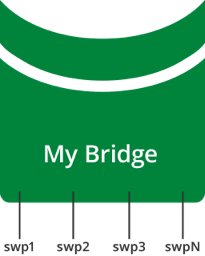Ethernet Bridging - VLANs
Ethernet bridges enable hosts to communicate through layer 2 by connecting all of the physical and logical interfaces in the system into a single layer 2 domain. The bridge is a logical interface with a MAC address and an MTU (maximum transmission unit). The bridge MTU is the minimum MTU among all its members. By default, the bridge’s MAC address is the MAC address of the first port in the bridge-ports list. The bridge can also be assigned an IP address, as discussed below.
Bridge members can be individual physical interfaces, bonds, or logical interfaces that traverse an 802.1Q VLAN trunk.

Use VLAN-aware mode bridges instead of traditional mode bridges. The bridge driver in Cumulus Linux is capable of VLAN filtering, which allows for configurations that are similar to incumbent network devices. For a comparison of traditional and VLAN-aware modes, read this knowledge base article.
Ethernet Bridge Types
The Cumulus Linux bridge driver supports two configuration modes; one that is VLAN-aware and one that follows a more traditional Linux bridge model.
NVIDIA recommends that you use VLAN-aware mode bridges instead of traditional mode bridges. The Cumulus Linux bridge driver is capable of VLAN filtering, which allows for configurations that are similar to incumbent network devices. For a comparison of traditional and VLAN-aware modes, read this knowledge base article.
You can configure both VLAN-aware and traditional mode bridges on the same network in Cumulus Linux; however you cannot have more than one VLAN-aware bridge on a switch.
- To create a VLAN-aware bridge, see VLAN-aware Bridge Mode.
- To create a traditional mode bridge, see Traditional Bridge Mode.
Bridge MAC Addresses
The MAC address for a frame is learned when the frame enters the bridge through an interface. The MAC address is recorded in the bridge table and the bridge forwards the frame to its intended destination by looking up the destination MAC address. The MAC entry is then maintained for 1800 seconds (30 minutes). If the frame is seen with the same source MAC address before the MAC entry age is exceeded, the MAC entry age is refreshed; if the MAC entry age is exceeded, the MAC address is deleted from the bridge table.
The following example NCLU command output shows a MAC address table for the bridge.
cumulus@switch:~$ net show bridge macs
VLAN Master Interface MAC TunnelDest State Flags LastSeen
-------- -------- ----------- ----------------- ------------ --------- ------- -----------------
untagged bridge swp1 44:38:39:00:00:03 00:00:15
untagged bridge swp1 44:38:39:00:00:04 permanent 20 days, 01:14:03
The CUE command to show a MAC address table for a bridge is cl show bridge domain <domain-id> mac-table.
bridge fdb Command Output
The Linux bridge fdb command interacts with the forwarding database table (FDB), which the bridge uses to store the MAC addresses it learns and the ports on which it learns those MAC addresses. The bridge fdb show command output contains some specific keywords:
| Keyword | Description |
|---|---|
| self | The FDB entry belongs to the FDB on the device referenced by the device. For example, this FDB entry belongs to the VXLAN device: vx-1000: 00:02:00:00:00:08 dev vx-1000 dst 27.0.0.10 self |
| master | The FDB entry belongs to the FDB on the device’s master and the FDB entry is pointing to a master’s port. For example, this FDB entry is from the master device named bridge and is pointing to the VXLAN bridge port: vx-1001: 02:02:00:00:00:08 dev vx-1001 vlan 1001 master bridge |
| extern_learn | The FDB entry is managed (or offloaded) by an external control plane, such as the BGP control plane for EVPN. |
The following example shows the bridge fdb show command output:
cumulus@switch:~$ bridge fdb show | grep 02:02:00:00:00:08
02:02:00:00:00:08 dev vx-1001 vlan 1001 extern_learn master bridge
02:02:00:00:00:08 dev vx-1001 dst 27.0.0.10 self extern_learn
- 02:02:00:00:00:08 is the MAC address learned with BGP EVPN.
- The first FDB entry points to a Linux bridge entry that points to the VXLAN device vx-1001.
- The second FDB entry points to the same entry on the VXLAN device and includes additional remote destination information.
- The VXLAN FDB augments the bridge FDB with additional remote destination information.
- All FDB entries that point to a VXLAN port appear as two entries. The second entry augments the remote destination information.
Considerations
- A bridge cannot contain multiple subinterfaces of the same port. Attempting this configuration results in an error.
- In environments where both VLAN-aware and traditional bridges are used, if a traditional bridge has a subinterface of a bond that is a normal interface in a VLAN-aware bridge, the bridge is flapped when the traditional bridge’s bond subinterface is brought down.
- You cannot enslave a VLAN raw device to a different master interface (you cannot edit the
vlan-raw-devicesetting in the/etc/network/interfacesfile). You need to delete the VLAN and recreate it. - Cumulus Linux supports up to 2000 VLANs. This includes the internal interfaces, bridge interfaces, logical interfaces, and so on.
- In Cumulus Linux, MAC learning is enabled by default on traditional and VLAN-aware bridge interfaces. Do not disable MAC learning unless you are using EVPN. See Ethernet Virtual Private Network - EVPN.